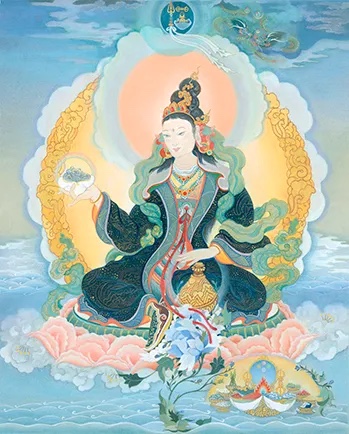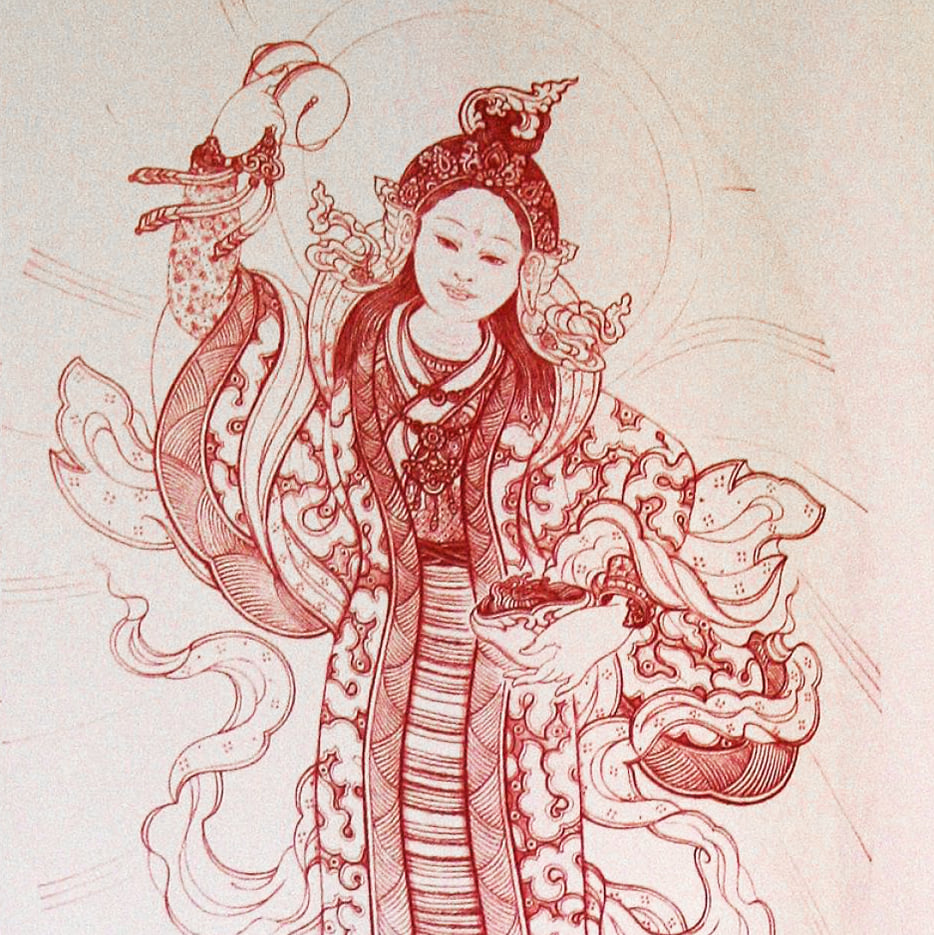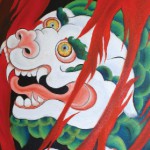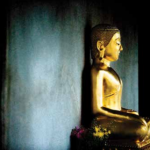Wednesday
Who Was Yeshe Tsogyal?
By Holly Gayley
Holly Gayley discusses the power of Padmasambhava’s foremost disciple and consort, Yeshe Tsogyal, and the life of one of her modern emanations.
Yeshe Tsogyal is the preeminent lady of Tibetan Buddhism. While most—if not all—of what we know about her life is highly mythologized, she is revered by Tibetans as a foremost disciple and consort of Padmasambhava, the eighth-century tantric master credited with a seminal role in establishing Buddhism in Tibet. Yeshe Tsogyal is also celebrated for transcribing Padmasambhava’s teachings and concealing them as treasures across the Tibetan and Himalayan landscape, to be revealed by successive tertöns, or “treasure revealers,” during times of strife.
In her well-known namthar, or story of “complete liberation,” which was revealed by the seventeenth-century tertön Taksham Nuden Dorje (available in English translations by Keith Dowman and the Padmakara Translation Group), Yeshe Tsogyal is portrayed as a gutsy woman striving for enlightenment. She faces various trials while practicing meditation in mountain solitudes: scorn from villagers, torment by demons, starvation, and even rape. Through these trials, she is shown transforming adversity into fuel for her practice and gaining realization. Moreover, in her namthar, one finds the striking statement by Padmasambhava that a woman with strong determination has a greater potential for attaining enlightenment than a man. In this way, Yeshe Tsogyal serves as an important example of a woman who traversed the Buddhist path.
However, if we think of Yeshe Tsogyal primarily as an ancestor who demonstrates that enlightenment is possible in female form, we grossly underestimate her significance for Tibetans. Moreover, we run into the problem (as with so many female figures in Buddhist literature) of establishing her historicity.
For Tibetans, Yeshe Tsogyal is not just a figure from the distant past; she remains an active and enduring presence. In the outer frame of her namthar, we see her portrayed as a timeless being—an emanation of Sarasvati—who took human form in Tibet for the sake of propagating the dharma. And at the end of her tale, before dissolving into space, Yeshe Tsogyal promises to continue to respond to the prayers of devotees, to appear to adepts in visions, and to continue to send forth emanations.
But her story does not end there. Over the centuries, Yeshe Tsogyal has remained accessible to ordinary Tibetans through numerous liturgies that supplicate her. In addition, her potent blessings are understood to remain in the places she practiced as well as the objects she touched (strands of hair, articles of clothing, ritual implements, etc.), considered to be relics of contact. To spiritual virtuosos, both male and female, Yeshe Tsogyal also appears in visions, posing riddles, offering encouragement, or expounding on the contents of a treasure teaching.
What’s more, Yeshe Tsogyal’s presence continues in the lives of historical women who are regarded to be her emanations. Indeed, exceptional women in the Nyingma school of Tibetan Buddhism are often identified as an emanation of Yeshe Tsogyal and sometimes referred to as “Yeshe Tsogyal in person.” Her emanations include the few female tertön known to us, such as Jomo Menmo (thirteenth century) and Sera Khandro (early twentieth century), as well as Mingyur Paldrön, the daughter and successor of the famed seventeenth-century tertön Terdak Lingpa, founder of Mindroling Monastery outside of Lhasa.
From one perspective, we could say that Yeshe Tsogyal serves as an authoritative precedent, creating a cultural space for female religious authority within the otherwise male-dominated Buddhist milieu in Tibet. From another perspective, through the women identified as her emanations, Yeshe Tsogyal continues to be an active presence, intervening in the lives of ordinary Tibetans.
To illustrate this, let me introduce a contemporary female tertön from the region of Golok in eastern Tibet: Khandro Tare Lhamo (1938–2002), an emanation of Yeshe Tsogyal who served as a beacon of hope for her local community during a devastating chapter of Tibetan history. The period leading up to and including the Cultural Revolution (1966–76) witnessed the destruction of most visible symbols of Tibetan culture: monasteries were closed, texts were burned, sacred objects were looted, monks and nuns were forced to defrock, and public religious observances were forbidden. Many lamas fled into exile or died in prison, including Khandro Tare Lhamo’s first husband and three brothers, who were incarcerated in the late 1950s.
Perhaps because she was a woman, Khandro Tare Lhamo was spared imprisonment, though I was told that she did endure beatings. On one harrowing occasion, officials placed her bare chest on a hot wood-burning stove. According to the old woman who told me this story, Khandro Tare Lhamo reflected on the far greater sufferings of beings in the hell realms, and as a result she had no burn marks afterward.
One cannot find such tales in her namthar, Spiraling Vine of Faith. Since it was published in China, most of her personal misfortunes and hardships are left out, likely due to the continued sensitivity of the “Tibet question.” For this reason, the stories told about Khandro Tare Lhamo in her namthar emphasize the miracles she performed for her local community, rather than the trials she endured. For example, during a famine in the wake of the Great Leap Forward, there is no mention of the hunger she and others must have faced; we read only of her miraculous ability to multiply a measure of rice to feed those around her. And while working as part of a crew constructing a pen for wild yaks, she is reported to have carried a stone too heavy for a group of men to lift, leaving an imprint of her hand in it.
These stories show how Khandro Tare Lhamo, as an enlightened being who took rebirth for the sake of others, embodied the paradox of being confined to her historical circumstances while seeming to transcend the laws of nature. Though miraculous in tenor—as when she reportedly stopped a rockslide threatening to overwhelm a crowd with a simple gesture of her hand—her activities were nonetheless grassroots in scale, addressing the immediate needs of her local community.
Khandro Tare Lhamo’s role in the Buddhist revival in Golok beginning in the 1980s was possible due to her identification with Yeshe Tsogyal. With the onset of China’s policy of “reform and opening,” religious observances were once again allowed, and Tibetans began an arduous process of rebuilding monasteries and recovering and reprinting precious texts. In Golok, treasure revelation played a significant role in this revival as a means to recover ancient teachings from amidst the debris. For the Nyingma, treasures are meant to be revealed during troubled times, when they promise to heal the damage to the teachings and beings, thereby heralding a new era for Buddhism and society to flourish.
As an emanation of Yeshe Tsogyal, Khandro Tare Lhamo was understood to have access to the teachings of Padmasambhava in the form of treasures, sealed in the Tibetan landscape and also in the mind stream of the tertön. Together with her second husband, Khandro Tare Lhamo revealed a twelve-volume corpus of treasure literature, including a volume dedicated to Yeshe Tsogyal and a series of female deities. From the mid-1980s onward, the couple traveled and taught together, propagating these treasures.
As these stories show, for Tibetans, Yeshe Tsogyal is more than an ancestor from the distant past or simply a role model to affirm women’s potential for enlightenment. Indeed, she remains an active presence in the lives of Tibetans–both men and women–through rituals dedicated to her and through the historical women who serve as her emanations. The well-known emanations of Yeshe Tsogyal mentioned above are only the tip of the iceberg. As time goes on, more and more stories of female adepts and spiritual teachers in Tibet are coming to light. Indeed, if present circumstances are any indication, for every female Buddhist teacher who made it into the historical record, there were at least a dozen or more on the ground. As the number of studies on exceptional Tibetan women grows, let us hope that we can consider not only issues of gender but also the impact and influence of these women on Buddhist history.
Reposted from Lion’s Roar December 1, 2007
*Judith Simmer-Brown will host Yeshe Tsogyal and the Feminine Principle through Shambhala Online beginning June 17, 2023. To Learn more and register please click here.
Entries filed under Dharma Teachings
Becoming a Bodhisattva – HIGHLIGHT
Sakyong Mipham Rinpoche, Dharma Teaching by Sakyong Mipham Rinpoche At the core of the Mahayana Buddhist teachings is the crown jewel of bodhichitta. This is the supreme thought, the highest possible concept that the mind can generate. Bodhichitta is the intention to bring all sentient beings to enlightenment. The ... continuePosted April 13, 2015 by
Like a Lion Licking Your Face – HIGHLIGHT
Dharma Teaching by Acharya Noel McLellan originally published on broken leaf The path of the Lion is connected with discipline and joy. Do the words “discipline and joy” go together for you? Here, discipline is not about rules and their enforcement. The outer level of form, rules, protocols, manners, ... continuePosted March 18, 2015 by
True Listening – HIGHLIGHT
Dharma Teaching by Sakyong Mipham Rinpoche It is said that when the Buddha first taught, two deer approached, knelt down, and raised their ears. They symbolize the act of listening, a sublime way of being present in the moment. Their perked-up ears represent keen attentiveness. Their bodies kneeling ... continuePosted March 16, 2015 by
Steadfast Clear Seeing – HIGHLIGHT
Dharma Teaching by Ani Pema Chodron originally published in Shambhala Sun As we meditate, we are nurturing five qualities that begin to come forth over the months and years that we practice. You might find it helpful to reconnect with these qualities whenever you ask yourself, “Why am I ... continuePosted February 28, 2015 by
Obstacles Arise – HIGHLIGHT
Dharma Teaching by Sakyong Mipham Rinpoche In meditation, we are on a journey from here to there — to whatever we are trying to accomplish, be it mindfulness, peace, or compassion. We are developing the ability to have fuller experience of our lives. But as we gain understanding ... continuePosted February 13, 2015 by
Becoming One With Dharma – HIGHLIGHT
Dharma Teaching by Sakyong Mipham Rinpoche We often bring the dharma into our life only when things come to a painful point — when we are facing a crossroads or experiencing confusion. Then we go into our library, dust off a book and crack it open. We try ... continuePosted January 5, 2015 by
Natural Brilliance – HIGHLIGHT
Leading from Within by Irini Rockwell We are singing the same song, in different languages. The Awake in the World online conference sponsored by Shambhala Mountain Center reached 80,000 people. Acharya Susan Skjei, talking about leadership, addressed three components: presence, engagement, and leading change. Acharya Fleet Maul, talking ... continuePosted December 26, 2014 by
Bravery = Showing Up – HIGHLIGHT
Monthly Dharma Teaching by Sakyong Mipham Rinpoche These days I am struck by the speed of life. As we get speedier, we do things in half steps. Therefore, the practice of whole-hearted engagement is important. How can we be steady and complete, and what kind of wisdom does ... continuePosted December 15, 2014 by
Embodying Wisdom, Becoming Sensational – HIGHLIGHT
Exploring the Five Wisdoms by Irini Rockwell A sensuous sixteen-year-old dancing; a couple in sexual union: ultimate wisdom and enlightenment are personified in the iconography of the Vajrayana Buddhist tradition by just such deities. They live in palaces, and offerings of sense pleasures are bestowed on them. Vajrayana ... continuePosted November 14, 2014 by
Shining Confidence – HIGHLIGHT
Sakyong Mipham Rinpoche, photo courtesy of BHH StudiosDharma Teaching by Sakyong Mipham Rinpoche We are all leaders, in that each of us is leading our life. We have no choice. We are making decisions moment-to-moment, even if it’s to butter our toast. To lead our lives well, ... continuePosted November 10, 2014 by
Inherent Dignity – HIGHLIGHT
Dharma Teaching by Sakyong Mipham Rinpoche Throughout history, the deepest minds have come to the conclusion that there is something profoundly worthy about being human. In the Shambhala tradition, we call this the sun of basic goodness. The sun is a symbol of life, warmth, and wholeness, like ... continuePosted October 13, 2014 by
A Picture of the Sky
Celebrating a collaboration between Naropa University and the University of Colorado on a Buddhist Studies Lecture Series in honor of Chogyam Trungpa Rinpoche …a course at the University of Colorado – Winter, 1971 (see part 1 here) Part 2 by John J. Baker …But there is another subtler way to ... continuePosted September 17, 2014 by
Investigating Motivation – HIGHLIGHT
Dharma Teaching by Sakyong Mipham Rinpoche In Buddhism, it is motivation that defines us what kind of practitioner we are. Simply put, the greater our motivation on the path, the greater our potential. Traditionally, there are said to be three kinds of motivation: small, medium, and large. Within the ... continuePosted September 5, 2014 by
The Threefold Purity – HIGHLIGHT
Curtis Pond in Calais, VT,COLUMN: Dharma Teachings by Ani Pema Chodron “To begin with, just give up any expectations of yourself. That’s a simple good instruction for how to do Buddhist meditation.” Buddhist meditation is about dissolving our fixation on ourselves, on the process of meditating, and on any ... continuePosted August 25, 2014 by
In with the Bad, Out with the Good – HIGHLIGHT
COLUMN: Dharma Teaching On Tonglen guest article by Shastri Ethan Nichtern orginally published on Shambhala Sun “Accepting and sending out” is a powerful meditation to develop compassion for ourselves and others. Shastri Ethan Nichtern teaches us how to do it in formal practice and on the spot whenever suffering arises. ... continuePosted August 11, 2014 by
![]() RSS feed for the Dharma Teachings category
RSS feed for the Dharma Teachings category
View all posts from authors in Dharma Teachings: Jillian_Johnson
































